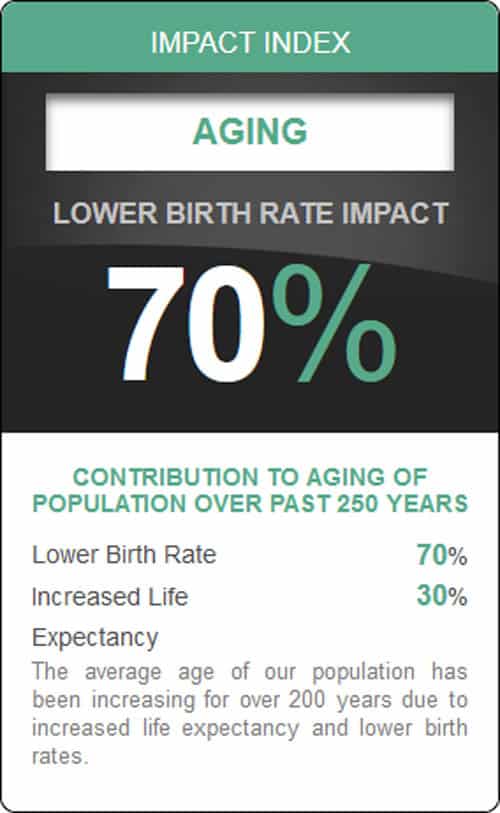Aging is a trend that sees an increase in the proportion of older people in our population and it is a natural trend which will continue until the Canadian population stabilizes.
The 1700s saw the start of the demographic transition which consisted of:
- lower fertility rates
- longer life spans and
- higher proportions of seniors
Aging is inevitable and simply cannot be reversed except by catastrophic population collapse or exponential population growth continuing forever.
The issue of aging has been presented as something which needs to be fixed. Certainly it must be understood and anticipated but aging is inevitable and is an integral part of a maturing nation.
Immigration has long been touted as a fix for an aging population. The objective of this fix seems to be to maintain forever the age structure and the rate of growth of the baby boom period. Attempting to boost immigration to levels which will run ahead of the aging trend will see extreme and ever-increasing levels of immigration with little effect on the age structure.
Why?
- The age structure of our immigration stream is not different enough to “youthenize” our population
- Aging is an inevitable part of the demographic transition from typical historically high birth rates and short life spans to the modern state of a stable population with low birth rates and long life spans
- Aging is a global phenomenon
But the aging issue isn’t really about demographics or the age structure, it is largely an economic argument. How will more seniors be supported?
Given that perspective, it is useful to examine the wage structure and employment trends and alter our policies to stimulate healthier, independent living and suitable employment opportunities. Higher incomes and lower unemployment levels is a much better approach than many low-quality jobs fed by large pools of cheap labour.
We need to recognize the aging process as inevitable and look to countries with age profiles 30 to 40 years ahead of our own who have adapted. Well thought out policies will allow us to progress into the future rather than attempt to fruitlessly maintain an unsustainable set of conditions from the past.
Demographic Transition
The aging trend is merely the tail end of the much larger demographic transition which has fundamentally shifted the historic demographic pattern from one that has endured for most of human existence to one that has accompanied the development of our modern societies.
In this transition, which began in earnest in the mid-18th century, life expectancy has increased from under 40 years to over 70 and the number of children per woman has decreased from 6 to near 2.
Achieving 70 years of age was a rare event in most previous human societies but is now expected as most developed countries approach a life expectancy of 80. Correspondingly, the preponderance of those under 15 has fallen from almost 40% to 20%.
The rapid population growth of the past 2 centuries has been due to the high birth rate being maintained while modern medicine and improved hygiene combined with vastly expanded oil based agricultural production to allow those born to live much longer.
Historically, populations have grown at a very slow rate and the explosion of the last 300 years is a singular even in human history. As societies have matured, the birth rate has fallen ending the phase of rapid growth for most developed countries. In fact, many have now achieved either a stable population or even one which is slightly declining.
This has resulted in an age structure which is unlike anything previously seen in human societies: one that features almost as many old people as young people.
The final stage in the demographic transition establishes the balance between young and old at levels much closer to parity as extensions in life expectancy flatten out.
This enormous demographic transition is not an endless trend but rather a pattern shift brought on by technology applied to food supply, social habits and medicine. Although over 300 years in the making, it is a singular event and requires society to transform in many ways to accommodate it rather than proceeding on the assumption that the transition process itself is the Anormal@ state.
Neither the aging trend nor the demographic transition are shifts that can be reversed. Understanding the nature of the changes and modifying our expectations of endless growth are the challenges which all countries will have to meet. Canada is fortunate that many advanced societies are decades ahead in this transition and are providing an excellent reference for the development of policies which will allow us to deal successfully with fundamental demographic changes.
Factoids on Aging
In hunter-gatherer societies, child births were spaced over 4 years apart. This was to allow the child to be at least partially mobile when the tribe migrated as only once child could be carried at a time. In agricultural societies which were stationary, childbirth spacing fell to two years.
Hunter-gather societies tended to be healthier due to their higher quality diets and had a greater life expectancy with many more people reaching 60 than was the case for agricultural societies. Women in agricultural societies typically gave birth to 6 children whereas women in hunter-gatherer societies had 4 children.
- Globe – In a radical change, Sweden scrapped its traditional defined benefit pension for what’s called a “notional defined contribution” plan (NDC).
- BMJ – Jeroen Spijker and John MacInnes argue that current measures of population ageing are misleading and that the numbers of dependent older people in the UK and other countries have actually been falling in recent yearsJeroen Spijker and John MacInnes argue that current measures of population ageing are misleading and that the numbers of dependent older people in the UK and other countries have actually been falling in recent years
- Wikipedia – Life expectancy is the expected (in the statistical sense) number of years of life remaining at a given age
- New Scientist – Japanese experience with aging
- Financial Post – Canada’s demographic time bomb – structural impact without the standard growth promotion




